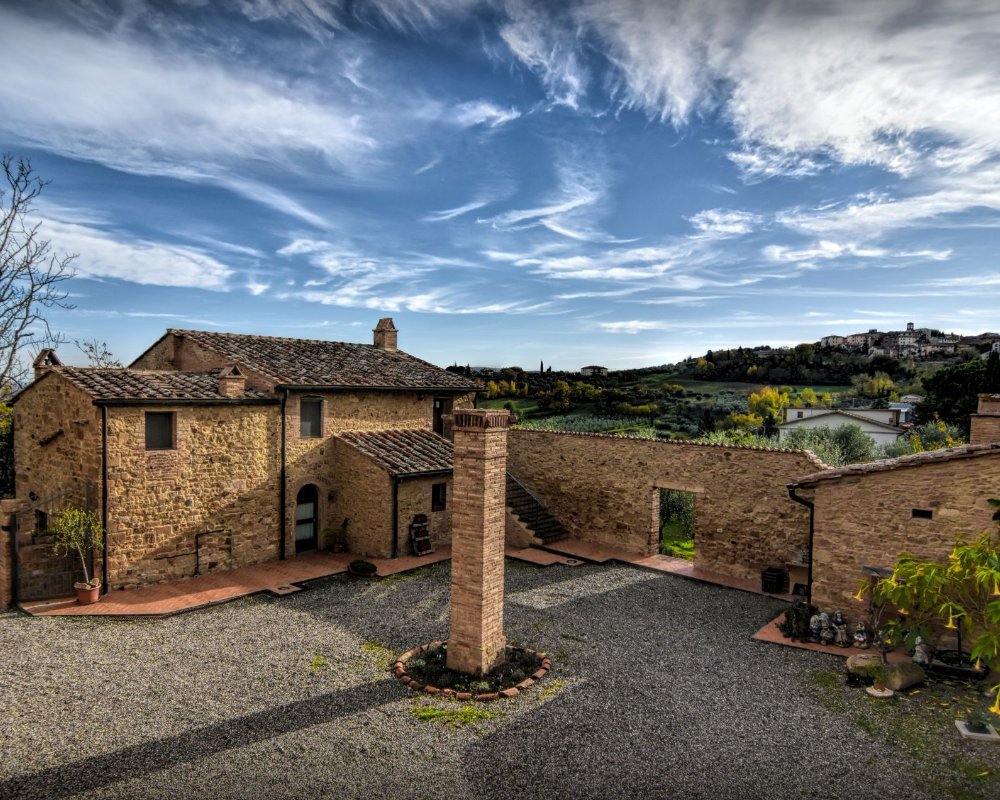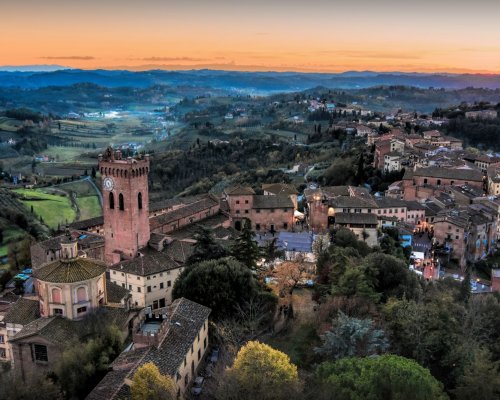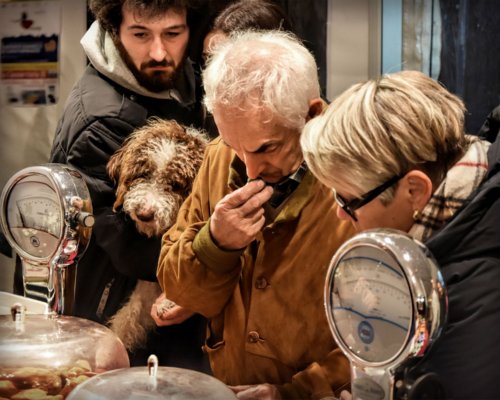What to do, see and sample along leg 30 of the Tuscan via Francigena
Seasoned hikers can conquer the 23.7 km stretch of the via Francigena leading from San Miniato to Gambassi Terme in under six hours, but why not make the fun last a bit longer? Transform an otherwise-challenging walk into a relaxing but still active weekend of exploration: take it slow, stopping off to see a mix of historic sites along the pilgrimage road—hospitality and monastic complexes, castles—and spots with appeal for today’s traveler—spas, excavation sites, eateries.
The journey begins in San Miniato, famous as a medieval hilltop town (and truffle-culture capital), but with evidence of human activity stretching back to prehistoric times: its small fraction Paesante holds the remains of a Bronze Age village. Sandwiched between contemporary Pisa and Florence, San Miniato is known for its lively local rituals and markets, which run year-round but vary according to the season: we’ll get to that shortly.
Begin your exploration with a visit to the Rocca di San Miniato defensive structure, which is a fine testament to the town’s longstanding reputation as strategically located (San Miniato spreads across three small hills, with bird’s-eye views of the Egola, Arno and Elsa valleys). The Rocca di San Miniato was completed at the beginning of the 13th century: from the top, you can see the meeting point of the Tuscan via Francigena with its Roman counterpart, which from Pisa snakes its way to Florence.
Also in your line of vision is the archaeological site of San Genesio, which was a stopping point along the via Francigena for numerous travelers during medieval times. It is generally considered to be the settlement out of which grew today’s San Miniato, beginning in the 13th century, and has earned the nickname “Tuscany’s lost capital.” For a closer look at its role as a hub for pilgrims, head to via Conti, where you can explore the findings of the excavation site at the Torre degli Stipendiari, which was formerly a carpentry workshop and is now the headquarters of the cultural association CRA (Centro Raccolta Arte). If your tastes are more modern, the association also hosts an array of lectures and events, frequently with a contemporary art focus.
Still, San Miniato’s pride and joy—the truffle—remains the town’s top attraction. Several internationally famous, mostly truffle-centered food festivals take place in the town. The most popular comes in autumn: the White Truffle Festival of San Miniato (Mostra Mercato Nazionale del Tartufo Bianco di San Miniato). Typically held over the last three weekends of November and the first weekend of December, the festival brings together gourmands, professional buyers and curious tasters for full days of open-air fun and truffle-based menus.
But don’t despair if your trip doesn’t land at that time of year: summertime travelers can take advantage of the Notte Nera (“Black Night”) in mid-June, which pays tribute the white truffle’s black twin; September visitors can carve out a stop in La Serra for the White Truffle Festival on the last weekend of the month; and early-autumn visitors can indulge at the Festa del Tartufo di Balconevisi on the third weekend of October. Get up-to-date information on all of these festivals at www.sanminiatopromozione.it.
Stay in San Miniato and get a good night’s rest for day two; you’ll have some substantial foot travel to make to get to Castelfiorentino.
The journey begins in San Miniato, famous as a medieval hilltop town (and truffle-culture capital), but with evidence of human activity stretching back to prehistoric times: its small fraction Paesante holds the remains of a Bronze Age village. Sandwiched between contemporary Pisa and Florence, San Miniato is known for its lively local rituals and markets, which run year-round but vary according to the season: we’ll get to that shortly.
Begin your exploration with a visit to the Rocca di San Miniato defensive structure, which is a fine testament to the town’s longstanding reputation as strategically located (San Miniato spreads across three small hills, with bird’s-eye views of the Egola, Arno and Elsa valleys). The Rocca di San Miniato was completed at the beginning of the 13th century: from the top, you can see the meeting point of the Tuscan via Francigena with its Roman counterpart, which from Pisa snakes its way to Florence.
Also in your line of vision is the archaeological site of San Genesio, which was a stopping point along the via Francigena for numerous travelers during medieval times. It is generally considered to be the settlement out of which grew today’s San Miniato, beginning in the 13th century, and has earned the nickname “Tuscany’s lost capital.” For a closer look at its role as a hub for pilgrims, head to via Conti, where you can explore the findings of the excavation site at the Torre degli Stipendiari, which was formerly a carpentry workshop and is now the headquarters of the cultural association CRA (Centro Raccolta Arte). If your tastes are more modern, the association also hosts an array of lectures and events, frequently with a contemporary art focus.
Still, San Miniato’s pride and joy—the truffle—remains the town’s top attraction. Several internationally famous, mostly truffle-centered food festivals take place in the town. The most popular comes in autumn: the White Truffle Festival of San Miniato (Mostra Mercato Nazionale del Tartufo Bianco di San Miniato). Typically held over the last three weekends of November and the first weekend of December, the festival brings together gourmands, professional buyers and curious tasters for full days of open-air fun and truffle-based menus.
But don’t despair if your trip doesn’t land at that time of year: summertime travelers can take advantage of the Notte Nera (“Black Night”) in mid-June, which pays tribute the white truffle’s black twin; September visitors can carve out a stop in La Serra for the White Truffle Festival on the last weekend of the month; and early-autumn visitors can indulge at the Festa del Tartufo di Balconevisi on the third weekend of October. Get up-to-date information on all of these festivals at www.sanminiatopromozione.it.
Stay in San Miniato and get a good night’s rest for day two; you’ll have some substantial foot travel to make to get to Castelfiorentino.
Today, make the trip to Castelfiorentino, located between the middle valley of the Arno and the northern portion of the Val d’Elsa; to reach it, you can take a train from the San Miniato-Fucecchio station to Castelfiorentino; like past pilgrims, you can enjoy the town’s tradition of hospitality by staying in a modest hostel tailor-made for weary travelers.
Like San Miniato, Castelfiorentino has strong associations with pilgrimage culture and heritage: not far away is the intersection of the via Francigena with the via Volterrana, and so Castelfiorentino welcomed numerous travelers resting on their journeys to Rome from northern Europe. It was also the site of one monumental truce—the signing of a 1260 peace pact between historic rivals Siena and Florence after the battle of Monteaperti.
Visitors know it best for its associations with Benozzo Gozzoli, the Renaissance painter behind Florence’s famous Cappella dei Magi at Palazzo Medici Riccardi. Although Castelfiorentino is not his birthplace, it is home to a museum dedicated to his memory (worth noting: the museum has been praised for its accessibility efforts, aimed at improving the experience for visitors with learning disabilities). Fresco cycles from the Tabernacles of the Madonna delle Tosse (1484) and the Madonna delle Grazie (1490-91), taken from their original locations and protected here, are the standout works to see. The latter tabernacle’s cycle was a group effort, carried out by Gozzoli and some of his collaborators.
The former contains a fresco depicting the Madonna nursing the baby Jesus, surrounded by saints and angels, and was designed to have an impressive trompe-l’oeil effect, appearing as a three-dimensional, framed altarpiece rather than a wall painting.
Also worth a stop is the Santa Verdiana Museum, home to a varied collection of artworks, manuscripts and religious vessels gathered from area churches. The crown jewel of the collection is a famed depiction of the Madonna and child by Cimabue, now nicknamed the Madonna of Castelfiorentino. Some scholars think that a young Giotto may have worked on it as well.
Museum-hopping will no doubt leave you hungry. In Castelfiorentino, tripe is king, and cured meats such as crumbly melt-in-your-mouth sbriciolona and bloody buristo are also popular. (Sorry, vegans!)
Today, make the trip to Castelfiorentino, located between the middle valley of the Arno and the northern portion of the Val d’Elsa; to reach it, you can take a train from the San Miniato-Fucecchio station to Castelfiorentino; like past pilgrims, you can enjoy the town’s tradition of hospitality by staying in a modest hostel tailor-made for weary travelers.
Like San Miniato, Castelfiorentino has strong associations with pilgrimage culture and heritage: not far away is the intersection of the via Francigena with the via Volterrana, and so Castelfiorentino welcomed numerous travelers resting on their journeys to Rome from northern Europe. It was also the site of one monumental truce—the signing of a 1260 peace pact between historic rivals Siena and Florence after the battle of Monteaperti.
Visitors know it best for its associations with Benozzo Gozzoli, the Renaissance painter behind Florence’s famous Cappella dei Magi at Palazzo Medici Riccardi. Although Castelfiorentino is not his birthplace, it is home to a museum dedicated to his memory (worth noting: the museum has been praised for its accessibility efforts, aimed at improving the experience for visitors with learning disabilities). Fresco cycles from the Tabernacles of the Madonna delle Tosse (1484) and the Madonna delle Grazie (1490-91), taken from their original locations and protected here, are the standout works to see. The latter tabernacle’s cycle was a group effort, carried out by Gozzoli and some of his collaborators.
The former contains a fresco depicting the Madonna nursing the baby Jesus, surrounded by saints and angels, and was designed to have an impressive trompe-l’oeil effect, appearing as a three-dimensional, framed altarpiece rather than a wall painting.
Also worth a stop is the Santa Verdiana Museum, home to a varied collection of artworks, manuscripts and religious vessels gathered from area churches. The crown jewel of the collection is a famed depiction of the Madonna and child by Cimabue, now nicknamed the Madonna of Castelfiorentino. Some scholars think that a young Giotto may have worked on it as well.
Museum-hopping will no doubt leave you hungry. In Castelfiorentino, tripe is king, and cured meats such as crumbly melt-in-your-mouth sbriciolona and bloody buristo are also popular. (Sorry, vegans!)
Wind down your trip with a walk to Gambassi Terme, another prime pilgrimage point long associated with Archbishop Sigeric the Serious of Canterbury (10th century). One of its main attractions comes before you reach the historic center, in the hamlet of Chianni, about 5 km from Gambassi Terme: the Parish Church of Santa Maria in Chianni, an example of late Romanesque architecture. Records show that it wa Sigeric’s twentieth stop on his personal return journey to Canterbury from Rome along the via Francigena. On the same grounds in the hamlet of Chianni, you’ll find the Ostello di Sigerico, a lodging place named for the archbishop that still welcomes contemporary pilgrims.
Gear up for a steep walk when you start heading toward Gambassi Terme itself: you’ll follow an incline until you reach the historic center, with its spa complexes located within the City Park. Kick back in one of these establishments—the waters here have been celebrated for centuries—or peruse the archaeological artifacts from the Etruscan-Archaic period (7th century BCE) in the Palazzo Civico.
For an alternative to this proposed itinerary, make your way to sleepy Montaione, a picture-perfect hilltop town overlooking the Valdelsa, where the old-style clock tower is the centerpiece and the pace of life is less hurried.
Chow down on chestnuts while you’re here, particularly if your trip lands in autumn: they dominate the woods around these parts. Late October typically brings the Truffle and Chestnut Festival, known locally as “TartuFesta”, a prime occasion to try some local specialties and products.
Most memorable here, however, is the Holy Mount of San Vivaldo (Il Sacro Monte di San Vivaldo), a pilgrimage site in every sense. Having earned the nickname “Tuscany’s Jerusalem” for its sacred origins, the site continues to draw contemporary pilgrims today. Its name comes from Vivaldo Stricchi, a 14th century Franciscan hermit from San Gimignano who chose the surrounding area here to live out a life of contemplation and fasting. Today, the architecture looks lavish compared to how he lived: he was found dead in the hollow of a chestnut tree that served as his house. A chapel was erected on that very spot to honor him, and since then a monastery and church have been added. Later, the Franciscans constructed a chapel complex which replicates the topography of some of Jerusalem’s most sacred spots, thus earning the site its nickname and drawing in international visitors unable to make it to the Holy Land itself.
Pat yourself on the back, pilgrim: this leg of the journey is complete.
Wind down your trip with a walk to Gambassi Terme, another prime pilgrimage point long associated with Archbishop Sigeric the Serious of Canterbury (10th century). One of its main attractions comes before you reach the historic center, in the hamlet of Chianni, about 5 km from Gambassi Terme: the Parish Church of Santa Maria in Chianni, an example of late Romanesque architecture. Records show that it wa Sigeric’s twentieth stop on his personal return journey to Canterbury from Rome along the via Francigena. On the same grounds in the hamlet of Chianni, you’ll find the Ostello di Sigerico, a lodging place named for the archbishop that still welcomes contemporary pilgrims.
Gear up for a steep walk when you start heading toward Gambassi Terme itself: you’ll follow an incline until you reach the historic center, with its spa complexes located within the City Park. Kick back in one of these establishments—the waters here have been celebrated for centuries—or peruse the archaeological artifacts from the Etruscan-Archaic period (7th century BCE) in the Palazzo Civico.
For an alternative to this proposed itinerary, make your way to sleepy Montaione, a picture-perfect hilltop town overlooking the Valdelsa, where the old-style clock tower is the centerpiece and the pace of life is less hurried.
Chow down on chestnuts while you’re here, particularly if your trip lands in autumn: they dominate the woods around these parts. Late October typically brings the Truffle and Chestnut Festival, known locally as “TartuFesta”, a prime occasion to try some local specialties and products.
Most memorable here, however, is the Holy Mount of San Vivaldo (Il Sacro Monte di San Vivaldo), a pilgrimage site in every sense. Having earned the nickname “Tuscany’s Jerusalem” for its sacred origins, the site continues to draw contemporary pilgrims today. Its name comes from Vivaldo Stricchi, a 14th century Franciscan hermit from San Gimignano who chose the surrounding area here to live out a life of contemplation and fasting. Today, the architecture looks lavish compared to how he lived: he was found dead in the hollow of a chestnut tree that served as his house. A chapel was erected on that very spot to honor him, and since then a monastery and church have been added. Later, the Franciscans constructed a chapel complex which replicates the topography of some of Jerusalem’s most sacred spots, thus earning the site its nickname and drawing in international visitors unable to make it to the Holy Land itself.
Pat yourself on the back, pilgrim: this leg of the journey is complete.


